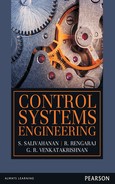Preface
The knowledge of control system is essential for engineering graduates in solving many stability design problems arising in electrical, mechanical, aerospace, biomedical and chemical systems. Since control system is an integral part of our modern society, it finds a wide range of applications in aircraft, robots and process control systems. We have developed this book for subjects, such as control system, process instrumentation, dynamics and control, aeronautical engineering and physiological control system, taught in B.E./B.Tech., AMIE and Grade IETE degree programs. The book will also serve as a useful reference for competitive examinations. We are optimistic that this book shall fill the void created by a lack of standard books on the subject of control systems. Ensuring this book available in the libraries of all universities, colleges and polytechnics will certainly help in enriching the readers. The various concepts of the subject have been arranged aesthetically and explained in a simple and reader-friendly language. For the better understanding of the subject, a large number of numerical problems with step-by-step solutions have been provided. The solutions to university questions have also been included. A set of review questions at the end of each chapter will help the readers to test their understanding of the subject.
This book is divided into 14 chapters. Chapter 1 deals with modeling of electrical and mechanical systems. Chapter 2 explains the various components and modeling of physical systems. Chapter 3 concentrates on the block diagram reduction technique in determining the transfer function of a system. Chapter 4 focuses on the signal flow graph in determining the transfer function of a system. Chapter 5 discusses time response analysis of the system. Chapter 6 describes the stability of the system using Routh’s array. Chapter 7 elaborates on root locus technique. Chapter 8 deals with frequency response analysis and Bode plot. Chapter 9 concentrates on polar and nyquist plot. Chapter 10 discusses constant M- and N-circles and Nichols chart. Chapter 11 is devoted to compensators of the system. Chapter 12 deals with physiological control system. Chapter 13 covers the state-space analysis of the system. Chapter 14 is devoted to MATLAB programs related to control systems. All the topics of this book have been illustrated with clear diagrams which are aided by lucid language to facilitate easy understanding of the concepts.
The book discusses about the intricacies of power generation using both renewable and non-renewable resources throughout its nineteen chapters. Conventional method of power generation and the system details have been covered in the first fourteen chapters while the non-conventional methods of power generation have been explained in chapters 15 and 16.
The chapters cover issues like thermal power plant, steam power plant, diesel engine power plant, gas turbine plant, hydro-electric plant, and nuclear power plant, power from non-conventional sources and power plant economics and Instrumentation. All chapters are supplemented by neat sketches and illustrations while SI units have also been used throughout the book which makes it a good reference for engineering students and teachers alike.
Key Features
Salient features of the book are:
Acknowledgements
We would like to sincerely thank the management of SSN College of Engineering, Chennai, for their constant encouragement and providing necessary facilities for completing this project. We are also thankful to our colleagues, especially V. S. Nagarajan and V. Thiyagarajan, Assistant Professors, and students Mandala Deekshith, B. Akshaya Padma Varshini and G. Deepika for their review and feedback to improve this book.
We are indebted to R. Gopalakrishnan and A. Chakkarabani of SSN College of Engineering, Chennai for word-processing the manuscript of the entire book.
A special thanks to Sojan Jose, R. Pritha and C. Purushothaman of Pearson India Education Services Pvt. Ltd, Chennai for bringing out this book successfully in a short span of time.
Finally, we extend heartfelt thanks to our family members—Kalavathy Salivahanan, S. Santhosh Kanna, S. Subadesh Kanna, Rajalakshmi Rengaraj, R. Harivarshan, R. Devprasath, G. S. Rajan Babu, Sumathi Babu, G. R. Hemalakshmi Prakash and G. R. Jeya Jeyaprakash— for their patience and cheerfulness throughout the whole process.
We will appreciate any constructive suggestions and feedback from the readers for further improvement of this book at [email protected].
S. Salivahanan
R. Rengaraj
G. R. Venkatakrishnan
